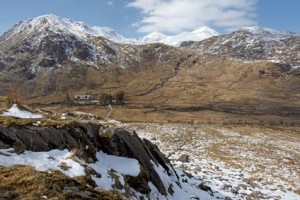Yorkshire Three Peaks 2014 – The Full Story
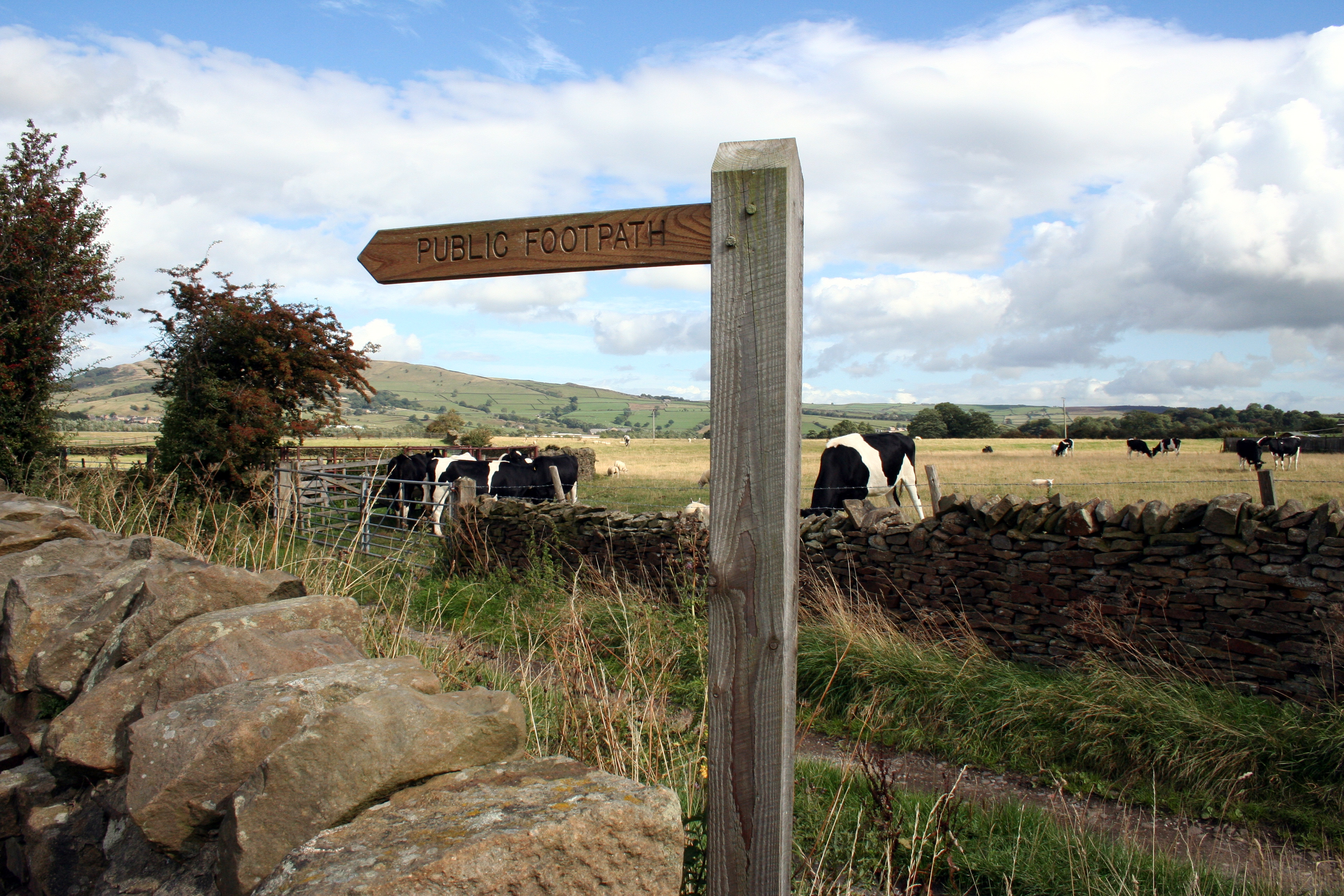
Completing the National Three Peaks in 2013 didn’t lead me to assume that the Yorkshire equivalent would be a walk in the park (although literally speaking, it is ACTUALLY a walk in a park).
The distance (just under 25 miles) is similar to N3P but without the cushy breaks while your driver transports you to the next mountain.
On the plus side I’d kept off the vast majority of the weight I lost for last year’s challenge and I’d found time to go on at least one walk every month since the turn of the year.
On the negative side my hectic work schedule had resulted in my being less regular with my cross-trainer workouts, and the May 30th 2014 date of the walk happened to coincide with an extended narcolepsy flare-up.
Basically I hadn’t had a good night’s sleep in a couple of weeks.
I had confidence in my ability to tough it out mentally, but I had more than a few concerns over my body’s ability to withstand the punishment…
Preparation Time
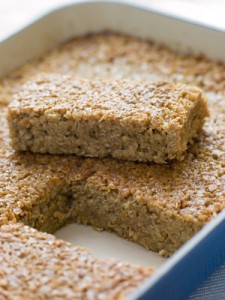 I took a day off work the day before the walk to allow myself time to prepare properly. Time I used to pack my bag, print out the Y3P route, download the waypoints to my GPS device, and cook up some food.
I took a day off work the day before the walk to allow myself time to prepare properly. Time I used to pack my bag, print out the Y3P route, download the waypoints to my GPS device, and cook up some food.
In the latter regard, my gluten-free, dairy-free, and nut-free diet limits my options somewhat but I’ve found that gluten-free sausages (protein) and oat cakes (carbs) work well and don’t add too much weight to my bag.
For a change, however, I decided to substitute oat cakes for home-made flapjacks. I hacked the recipe a little by adding sunflower seeds, pumpkin seeds, dates, and dark chocolate.
I planned to be up by 3am the next morning so I went to bed at 7pm and did my best to sleep…
Which didn’t really work out.
I dozed a little between 8pm and 9pm but was then wide awake until after 11pm.
Early Start
I rose fairly easily at 3am. A bit earlier than strictly necessary but it gave me time to get a cool shower and put on all my gear.
I left at around 3:45 and went to pick up my younger sister, Bethany, who had kindly agreed to come along so I wouldn’t have to drive home at the end of the day in what I assumed would be a fairly worn-out condition.
As planned we arrived at a McDonald’s near Skipton at 5am, just as it opened. I filled up on two eggs, four strips of bacon, and four hash browns (all gluten-free and dairy-free providing you ask them to serve it on a tray instead of in a sandwich).
Not the most nutritious breakfast in the world, but tasty and high in calories.
We pushed on at about 5:30am and arrived in Horton-in-Ribblesdale at around 6:45am
A quick talk from Kuta Outdoors (the organisers) and Simon on the Streets (the charity everyone was walking for that day), and we set off at around 7:10am.
The Challenge
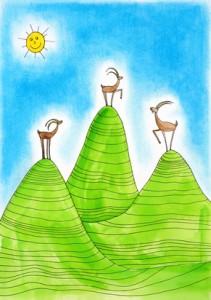 If you’re not familiar with the Yorkshire Three Peak challenge, it’s a 24.5 mile circular walk that includes climbing and ascending the three highest peaks in the Yorkshire Dales: Pen-y-ghent (2277ft), Whernside (2415ft) and Ingleborough (2372ft).
If you’re not familiar with the Yorkshire Three Peak challenge, it’s a 24.5 mile circular walk that includes climbing and ascending the three highest peaks in the Yorkshire Dales: Pen-y-ghent (2277ft), Whernside (2415ft) and Ingleborough (2372ft).
Despite what some people claim, these peaks ARE mountains. And although they only just qualify (2,000ft is the UK definition – http://en.wikipedia.org/wiki/Mountain#Definition), they still each represent a sizeable walking challenge.
Although 14-15 hours would generally be considered a reasonable time for a walk of this distance and elevation, the traditional goal of the Y3P challenge is to complete the circuit in under 12 hours.
To be fair, completing the walk in a single day without collapsing from exhaustion should be considered a win, but I really, really wanted to finish the circuit within the allotted time.
I’d decided, weeks earlier, that I would aim to complete the walk in 10 hours, but settle for 11 hours.
If injury hit, then I’d just be happy to finish inside 12 hours.
The Route
With several dozen people tackling the challenge on the day I assumed I’d be able to follow those already familiar with the route. But within a couple of minutes of starting I realised most people weren’t in a hurry to get up to speed.
Fortunately I had my GPS and map (thank you go4awalk.com) with me and I wasted no time in figuring out the direction I was supposed to be heading and striding out.
Once the path began to climb, some of the hardier walkers overtook me. As tempting as it was to try and keep up I had the sense to focus on maintaining the pace with which I was comfortable.
My plan was simple…
Maintain an average of 2.5mph and a time of around 10 hours was assured.
Simple, right?
Peak 1: Pen-y-ghent
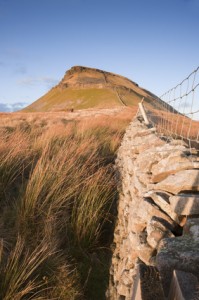 From the start point, the first peak is only around 2.5 miles as the crow flies. Of course, what that really tells you is that this is a very steep walk.
From the start point, the first peak is only around 2.5 miles as the crow flies. Of course, what that really tells you is that this is a very steep walk.
In fact, I would go so far as to say that Pen-y-ghent rivals Scafell Pike for the crown of “irritatingly, inappropriate gradient”.
Overly keen to maintain a good pace I made the – apparently common – mistake of pushing too hard. For the first time on a walk I felt a little nauseous and woozy.
Once the climb leveled out I quickly recovered and hit the first peak after 1hr and 10mins.
The map I used provided target times for various points, based on a 12-hour pace, and suggested 2 hours as the target for the first peak.
I was already 50 minutes ahead of schedule!
Disaster!
I swigged some water, crunched a few mouthfuls of a seed bar, and then walked down the other side of the mountain.
The path was wide, well-maintained, and I was able to get up a cracking pace. At “Pen-y-ghent Side” the Y3P route changed a couple of years ago to help walkers avoid some seriously boggy ground. Helpfully this is signposted and, as with most of the walk, keeping on track wasn’t difficult.
But about a mile later…
I started to feel some rubbing on the balls of both feet.
In 18 months of walking, I had never experienced blisters. But now I had to accept the fact that I was in danger of developing them.
I checked my GPS (it handily tracks the distance I’ve walked and my average speed) which said I’d walked around four miles.
How could I be getting blisters so soon?
Only two months earlier I’d completed a 13-mile walk in torrential rain, soaking me through completely, without even the tiniest blister.
What had changed?
The only thing I’d done differently that morning from my previous walks was to put on two pairs of socks, ironically because this is supposed to help reduce blisters.
Irritated at having to lose time I stopped and removed my boots. Both pairs of socks were soaked through with sweat, presumably a combination of hard, fast walking, and…
Too much insulation.
Two pairs of socks is probably fine if they’re made of a thin material but, like a moron, I’d put on two thick pairs of sports socks.
Obvious with hindsight, of course.
I had no visible blisters at this point but the balls of both feet were red and a little sore.
I pondered what to do, keen to get moving again as soon as possible. I had blister patches with me but I didn’t yet have any blisters.
Again, serious moron alert!
Blister patches can be applied on sore areas BEFORE a blister appears, reducing friction.
But I didn’t think of that…
Instead of took off one pair of socks to try and reduce the sweating and marched on.
The rubbing didn’t diminish and gradually got worse over the next couple of miles. I was still able to keep a decent pace but I could feel myself slowing, in part because my gait changed to try and reduce pressure on the sore areas.
Peak 2: Whernside
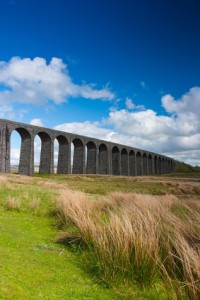 I reached the B6255 at Ribblehead, at the base of Whernside, after around 3hrs 40 mins, still around 1hr ahead of the 12-hours schedule.
I reached the B6255 at Ribblehead, at the base of Whernside, after around 3hrs 40 mins, still around 1hr ahead of the 12-hours schedule.
There’s a small car park and a tea van, and a quite a few walkers were using this area as an opportunity to eat and rest.
I re-examined my feet to discover huge blisters on the balls of both my feet, once of which extended all the way up between two of my toes.
I cleaned my feet as best as I could and applied the blister patches – too little too late but I hoped it might stop them from getting worse.
I was about to change my socks when a fellow walker generously offered me a pair of new, clean walking socks. Normally I wouldn’t accept underwear from a stranger but in this case I was only too happy to accept this generosity.
Pulling on fresh socks felt great. Buoyed, I took on some more water and then set off once more heading up alongside the Ribblehead viaduct
My renewed zeal for the challenge didn’t last long. The blister patches, despite my desperate hope, did nothing to quell the pain I felt with every step.
More worryingly my legs felt like rubber and I felt genuinely fatigued.
I checked my GPS.
I still had around 14 miles to go, representing anywhere between 6-8 hours of walking.
This was much too early to begin running out of energy. I couldn’t recall ever feeling this tired this early into a walk.
Was it the blister pain?
Perhaps it was simply in my head. My body saying it didn’t want to walk on sore feet.
I did my best to ignore the pain and fatigue by trying to count to 64 in binary (don’t ask me why – I don’t have an answer that doesn’t make me sound like a colossal geek).
It didn’t really help.
The walk up Whernside is quite long and fairly gradual but as it started to get steeper it became clear that the fatigue wasn’t in my head. My breathing was laboured and my pulse rate was soaring.
I felt unbelievably frustrated. The uphill part of a walk is usually one of my strengths. I pride myself on being able to keep up a steady, unbroken pace. “Don’t stop until you get to the top” is a mantra I try to stick to but this now seemed to be impossible.
Just before the path crossed a stile towards “Grain Ing” I sat down to rest and take on some water.
I watched miserably as an elderly couple overtook me.
To be fair, they weren’t part of the Y3P group, but psychologically I’ll admit that this depressed me.
I set off again determined that I was going to take no further rests until I hit the peak. I could slow down, I could zig-zag when it got steep, but I would… not… stop…
That determination lasted about 5 minutes.
As the gradient increased my pulse soared again and I realised if I didn’t stop and catch my breath I might end up passing out.
An older chap – who appeared to be at least in his 60s – jogging down the mountain, greeted me with a hearty “hello”, clearly not even slightly out of puff.
I responded with a noise that may or may not have been an attempt at speech.
I checked my GPS and my map. At 12 miles in I was almost half-way in which was encouraging.
Better yet, as long as I reached the peak in the next hour and a half, I would still be an hour ahead of schedule and on target for an 11-hour finish.
That sounded doable. I pressed on, pausing to catch my breath and allow my heart rate to subside when I needed.
The path turned south about half a mile from the summit and I felt something that could almost be described as a second wind. I was able to walk and breathe a little easier, allowing me a moment or two of clarity to actually enjoy the incredible view of the Yorkshire Dales.
I reached the peak of Whernside just under 5.5 hours into the walk.
Somehow I’d picked up some time and was now almost 2 hours ahead of the 12-hour schedule.
Blisters Suck!
 I tucked into a sausage, immediately regretting my decision earlier in the week to try a different brand of gluten-free sausage. Describing it as bland and tasteless would be elevating it to a stature of gastronomic magnificence that it didn’t deserve.
I tucked into a sausage, immediately regretting my decision earlier in the week to try a different brand of gluten-free sausage. Describing it as bland and tasteless would be elevating it to a stature of gastronomic magnificence that it didn’t deserve.
More water and, despite packing a weighty three litres, for the first time I felt a little concerned that I may run out.
It was an overcast day but it was dry and warm and I wondered if I might have underestimated the fluid intake required.
The other side of Whernside is almost perilously steep and the path is very rocky. It was at this point in the walk that my existence in the universe shrank to two small areas on the soles of my feet.
If you’ve ever tried to walk on epic blisters I hope you can spare a little sympathy for the teeth-gritting ordeal I was going through. Every step sent a throb to the centre of my brain and I tried not to think about the final peak that still remained to be conquered.
At the base of Whernside the path improved and so did the pain. It wasn’t that my feet hurt less, I had simply reached the point where I felt I could push it into the background and not think about it as much.
The pain wasn’t going to get any worse so it was no longer something to worry about.
A couple of miles later I reached the “Old Hill Inn”.
I was around 6¾ hours into the walk which put me around 90 minutes ahead of schedule. I was losing time now but I was still making good progress and I felt confident of a time under 11 hours.
I sat cross-legged in the “Old Hill Inn” car park, ate, drank, and then began the final peak.
Peak 3: Ingleborough
The first part of the Ingleborough climb is fairly innocuous. Fields, gates and then eventually some paved steps that lead you up.
Nothing too arduous.
And yet, all the time, looming high above you, is the mountain peak with no easily discernable path to take you up it.
It wasn’t hard to figure out from my map that the climb was going to be steep. I had ¾ of a mile to go the summit and the ascent had barely begun.
And, helpfully, the path on the map is labelled: “very steep”
That, ladies and gentlemen, is an understatement.
On the Ingleborough climb you eventually reach what appears to be a rough, stone, zig-zag staircase that takes you up an almost vertical ascent.
There’s no messing around with this one. Even if I’d felt fighting fit I still wouldn’t have rushed this part of the climb.
I climbed slowly, resting for 15-20 seconds every 20-30 metres.
After climbing the fell, the gradient reduces slightly, but only slightly. I pushed on as best as I could and reached the summit after almost exactly 8.5 hours of walking (which, by the way, was about 40 minutes AFTER the fastest walker on the day completed the entire circuit!).
And Back Again…
According to the map, the final leg of Y3P, is 4.75 miles. At a brisk pace of just over 3mph, this meant I was potentially only 90 minutes from completion.
Suddenly a 10hr walking time was back on the cards.
Adrenaline kicked in and I set off down the other side of Ingleborough at a strong pace.
I vaguely realised that I was now getting some soreness on my right heel but I rejected the idea of stopping for another blister patch.
The end was in sight.
Before long, however, I was forced to slow down by the terrain. The path was rocky, muddy and at one point I almost ended up face-first in a muddy puddle. My legs kept threatening to go into cramp but I managed to keep moving.
I passed a signpost that announced I had 2 miles to go and without warning I hit a wall.
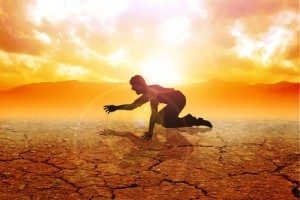
The pace I’d foolishly pushed myself to maintain for the last 2.75 miles had caught up with me and it took a pure act of will to keep moving, albeit at a greatly reduced pace.
Two miles to go and 9hrs 15mins on the clock.
I’m still convinced the signpost was a lie. That two miles seemed to go on…
And on…
And on…
It took me around 25 minutes to reach the 1 mile marker and I was getting slower and slower.
The blisters seemed to be getting more painful and my legs felt as if they were stiffening up.
At the 9hrs 50mins mark I accepted that a finish time under 10 hours was a pipe-dream.
The goal now was to get to the end without injury.
When I reached the brow of the final descent and saw the finish point in the mid-distance I felt an exhilarating wave of relief.
That didn’t translate into energy however, and I limped to the finish line, after walking 24.87 miles, in a time of 10 hours and 7 minutes (Simon on the Streets had my time as 10 hours and 5 minutes but I’m going by the GPS time).
If you’d offered me that time at the start I’d have taken it with both hands.
End Notes
First up, here’s the lessons I learned from mistakes made.
- Don’t be a cheapskate, buy some proper lined walking socks.
- Carry spare socks and foot powder (when I did N3P I changed socks before every mountain but I didn’t this time because it meant extra weight in my bag – the extra weight would have been worth it).
- Don’t have breakfast at McDonalds (porridge or muesli is more sensible).
- Take more water than you think you need (3 litres wasn’t enough in the end).
- Dress for the weather and remove layers if you’re warm (I didn’t and sweated excessively and unnecessarily).
- Apply blister patches at the FIRST signs of rubbing.
- Don’t overdo it with the energy drinks (they give you a quick boost but at the expense of the dehydrating effects of caffeine – I should have stuck with water and glucose tablets if I needed an extra boost).
- The flapjack was great but I should have left out the dark chocolate (made me thirstier).
With hindsight I think the fatigue I experienced early on was a combination of being in a bad sleep patch, and dehydration caused by a dodgy breakfast, too many energy drinks, too many layers of clothing and not bringing along enough water.
It’s hard to say that I enjoyed the journey but the sense of satisfaction afterwards, as with the N3P, was superb.
At the time of writing I’ve raised £225 (+£36.25 in Gift Aid). Thank you to everyone who sponsored me.
If you found my story entertaining, please consider making a donation to Simon on the Streets and help them help the long-term homeless. Visit http://www.justgiving.com/davidcongreave or http://www.simononthestreets.co.uk/
What’s Next?
Around two-thirds of the way through the Y3P I decided that I’d cured myself of my interest in endurance walking challenges.
But less than half an hour after completing the walk…
I started thinking about the Welsh 3000s.
15 peaks… 30+ miles… 24 hours…
